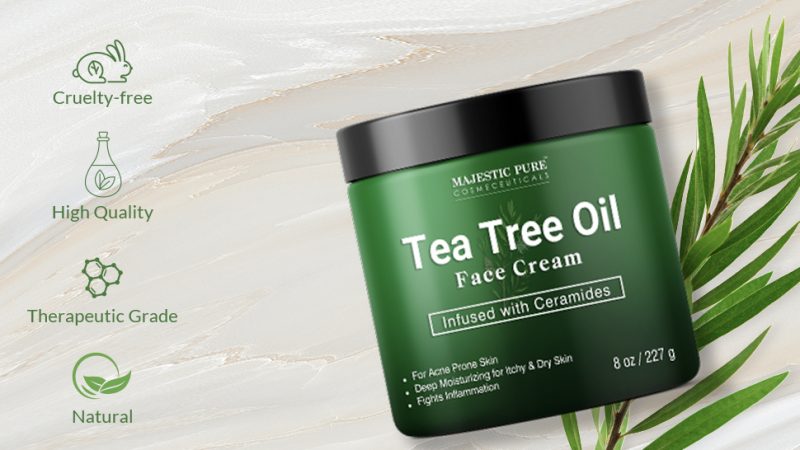How Tea Tree Oil Helps with Scabies: Benefits, Uses, and Precautions

Scabies is a highly contagious skin condition caused by the infestation of the Sarcoptes scabiei mite. Characterized by intense itching, rash, and inflammation, scabies can be both uncomfortable and distressing. Traditional treatments often involve prescription medications, but tea tree oil has emerged as a popular natural remedy due to its potent antiparasitic, anti-inflammatory, and antimicrobial properties. Here’s an in-depth look at how tea tree oil helps with scabies, its benefits, uses, and essential precautions.
Benefits of Tea Tree Oil for Scabies
- Antiparasitic Properties
Tea tree oil contains several compounds, including terpinen-4-ol and 1,8-cineole, which exhibit antiparasitic effects. These compounds help to target and eliminate the scabies mites that cause the infestation. Research indicates that tea tree oil can penetrate the mites’ exoskeleton and disrupt their metabolic processes, leading to their death.
A study published in Parasitology Research found that tea tree oil effectively kills Sarcoptes scabiei mites when used at appropriate concentrations. The oil’s ability to disrupt the mites’ environment makes it a valuable adjunct in managing scabies.
- Anti-Inflammatory Effects
One of the most troubling symptoms of scabies is severe itching, which is often accompanied by inflammation and redness. Tea tree oil’s anti-inflammatory properties help to reduce inflammation and soothe the irritated skin. By decreasing the production of inflammatory cytokines, tea tree oil can provide relief from the itching and discomfort associated with scabies.
The Journal of Dermatology notes that tea tree oil’s anti-inflammatory effects can help mitigate the skin irritation and inflammation often seen in scabies patients.
- Antimicrobial Action
Tea tree oil’s antimicrobial properties help prevent secondary bacterial infections that can arise from scratching and broken skin. The oil inhibits the growth of bacteria and fungi, which can exacerbate scabies symptoms and complicate the condition.
According to research in Clinical Microbiology Reviews, tea tree oil’s broad-spectrum antimicrobial activity supports wound healing and reduces the risk of infection, making it particularly useful for managing scabies-related skin lesions.
How to Use Tea Tree Oil for Scabies
- Topical Application
For effective treatment of scabies, tea tree oil should be diluted with a carrier oil to avoid skin irritation. The mixture can be applied directly to the affected areas to target the mites and alleviate symptoms.
How to Use:
- Mix 10-15 drops of tea tree oil with 1 tablespoon of carrier oil (such as coconut, olive, or almond oil).
- Apply the mixture to the affected areas of the skin, ensuring even coverage.
- Leave the oil on for at least 30 minutes before washing it off with lukewarm water.
- Repeat the application 1-2 times daily until symptoms improve.
- Bath Soak
A bath soak with tea tree oil can help soothe the entire body and address widespread infestations. The oil’s antiparasitic and anti-inflammatory properties can penetrate the skin and provide relief from itching and irritation.
How to Use:
- Add 10-15 drops of tea tree oil to a warm bath.
- Soak in the bath for 15-20 minutes, ensuring the affected areas are immersed.
- Pat the skin dry with a clean towel and avoid rubbing.
- Use this treatment once daily or as needed to relieve symptoms.
Precautions and Considerations
- Dilution is Essential
Tea tree oil is highly concentrated and can cause skin irritation if applied undiluted. Always mix tea tree oil with a carrier oil before applying it to the skin. Perform a patch test on a small area of skin to check for any allergic reactions or sensitivities before widespread application.
- Consult a Healthcare Provider
While tea tree oil can be an effective adjunct treatment for scabies, it should not replace conventional medical treatments prescribed by a healthcare provider. Always consult with a dermatologist or healthcare professional before starting any new treatment, especially if you are pregnant, breastfeeding, or have pre-existing skin conditions.
- Avoid Sensitive Areas
Tea tree oil should be used with caution around sensitive areas of the body, such as the face, genitals, and mucous membranes. Avoid applying it to broken or irritated skin, as this can increase the risk of irritation.
- Monitor for Side Effects
While rare, some individuals may experience side effects such as redness, itching, or a burning sensation. If these symptoms occur, discontinue use and consult a healthcare professional.
Final Thoughts
Tea tree oil offers a natural and effective approach to managing scabies, with benefits that include antiparasitic, anti-inflammatory, and antimicrobial effects. When used properly, tea tree oil can help alleviate symptoms, reduce inflammation, and prevent secondary infections associated with scabies. However, it is essential to use the oil with caution, ensuring proper dilution and consulting with a healthcare provider to ensure a comprehensive treatment approach.
Incorporating tea tree oil into your scabies management plan can enhance relief and contribute to a more comfortable healing process. Always follow safety guidelines and seek professional medical advice to ensure the best outcomes for your condition.
Sources:
- Parasitology Research. (2009). Antiparasitic activity of tea tree oil against Sarcoptes scabiei.
- Journal of Dermatology. (2002). The anti-inflammatory effects of tea tree oil in skin conditions.
- Clinical Microbiology Reviews. (2006). Antimicrobial properties of tea tree oil and its application in skin infections.






